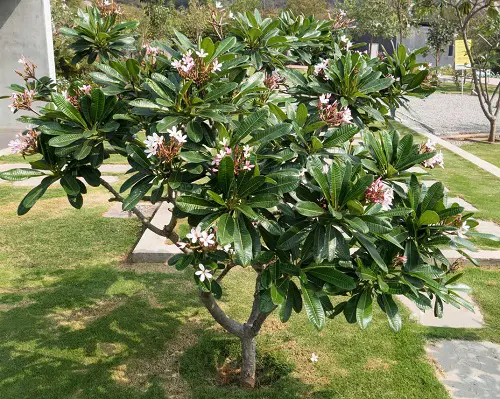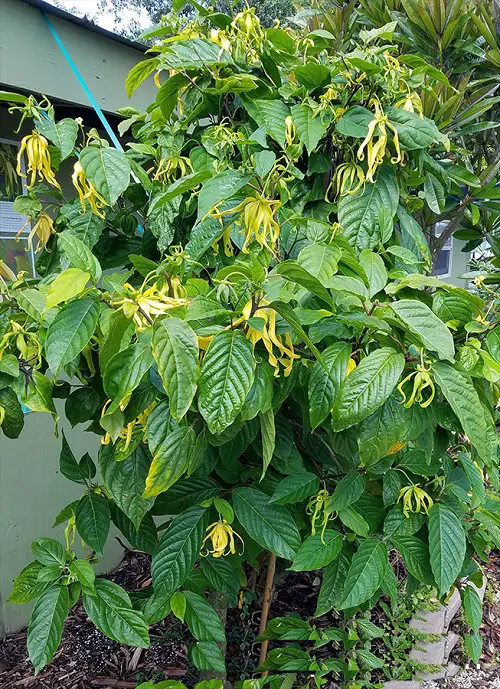Here’s an exclusive list of the Best Fragrant Trees that you can grow in the garden! Some of them also have beautiful blooms!
If you are looking for beautiful, Fragrant Trees for your yard, then this list is for you. Fill your outdoor space with delightful scents and create a refreshing atmosphere.
Best Fragrant Trees
1. Cedar Tree

Botanical Name: Cedrus
USDA Zones: 6-9
The Cedar Tree is renowned for its strong and distinctive fragrance. The wood and leaves of the tree exude a warm and woody scent that is often used in perfumes and aromatic oils.
2. Eucalyptus
Botanical Name: Eucalyptus globulus
USDA Zones: 8-11
Thanks to the aromatic oils present in the leaves, these fragrant trees have a refreshing and invigorating scent that is both soothing and uplifting.
3. Magnolia

Botanical Name: Magnolia spp.
USDA Zones: 7-9
Magnolias are known for big flowers that make the spring air smell sweet and strong. The blooms are shaped like tulips and come in pink, purple, white, and yellow hues.
Check out the Most Fragrant Climbers for Walls in the Garden here
4. Frangipani
Botanical Name: Plumeria spp.
USDA Zones: 10-12
These fragrant trees produce beautiful, highly fragrant flowers in shades of white, yellow, pink, and red. They are commonly found in tropical and subtropical regions.
Here is How to Grow Plumeria from Cuttings
5. Orange Tree

Botanical Name: Citrus sinensis
USDA Zones: 9-11
Orange trees, particularly the sweet orange variety, produce fragrant white flowers known as orange blossoms. The scent is fresh and citrusy.
Here is How to Grow an Orange Tree in Container
6. Lilac
Botanical Name: Syringa spp.
USDA Zones: 3-7
Lilac trees are known for their clusters of small, highly fragrant flowers that come in various shades of purple, pink, and white. These fragrant trees bloom in spring.
Here is How to Grow Miss Kim Lilac
7. Ylang-Ylang Tree
Botanical Name: Cananga odorata
USDA Zones: 9-11
Ylang-ylang trees have highly fragrant yellow flowers with a sweet and exotic scent. The flowers are used in the production of perfumes.
Here is How to Grow Ylang-Ylang Tree Easily
8. Canadian Hemlock

Botanical Name: Tsuga canadensis
USDA Zones: 3-7
Eastern hemlocks are native evergreen trees found in the forests of eastern North America. These fragrant trees have two-toned green needles that exude a delightful scent.
9. American Wisteria

Botanical Name: Wisteria frutescens
USDA Zones: 5-9
These fragrant trees produce cascades of fragrant, pendulous flowers in shades of purple, pink, or white. They are popular for their showy appearance and sweet scent.
10. Linden
Botanical Name: Tilia spp.
USDA Zones: 3-7
Linden trees, also known as lime or basswood trees, produce small, fragrant flowers in late spring or early summer. The flowers are often used to make herbal teas.
Check Night Blooming Fragrant Flowers with Strong Scent here
11. Michelia

Botanical Name: Michelia spp.
USDA Zones: 10-11
Michelia trees, related to magnolias, produce scented flowers that resemble magnolia blooms. They come in various colors and are highly fragrant.
12. Crabapple
Botanical Name: Malus spp.
USDA Zones: 4-8
Some varieties of crabapple trees produce fragrant flowers in spring. The scent can vary depending on the specific cultivar.
Check out our article Growing Crabapple Trees here
13. Sweetbay Magnolia
Botanical Name: Magnolia virginiana
USDA Zones: 5a-10a
Sweetbay magnolia trees have creamy-white, lemon-scented flowers that bloom in late spring or early summer. These fragrant trees are native to the southeastern United States.
14. Camellia
Botanical Name: Camellia spp.
USDA Zones: 7-9
Camellia trees produce flowers in various colors, including white, pink, and red, with a pleasant fragrance. These fragrant trees bloom in late winter or early spring.
Check Houseplants that are Literally Fragrant Air Fresheners here
15. Osmanthus
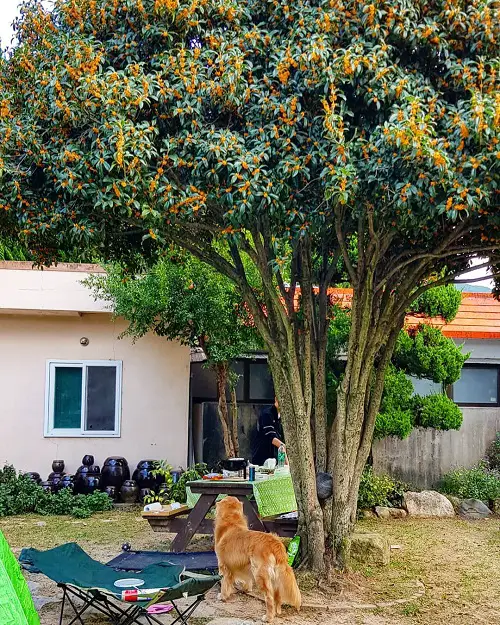
Botanical Name: Osmanthus spp.
USDA Zones: 7b-9b
Osmanthus trees, also known as sweet olive trees, produce small, highly fragrant flowers in shades of white, orange, or yellow. The scent is often described as apricot-like.
16. Mock Orange
Botanical Name: Philadelphus spp.
USDA Zones: 4-8
Mock orange trees are known for their highly fragrant, white, or cream-colored flowers. The scent is reminiscent of citrus blossoms and can fill the air with a sweet fragrance.
17. Golden Chain Tree

Botanical Name: Laburnu x watereri
USDA Zones: 5-7
These fragrant trees are visually stunning with their golden racemes and have a strong fragrance. They bloom in spring but have a relatively short flowering period.
18. Silk Tree
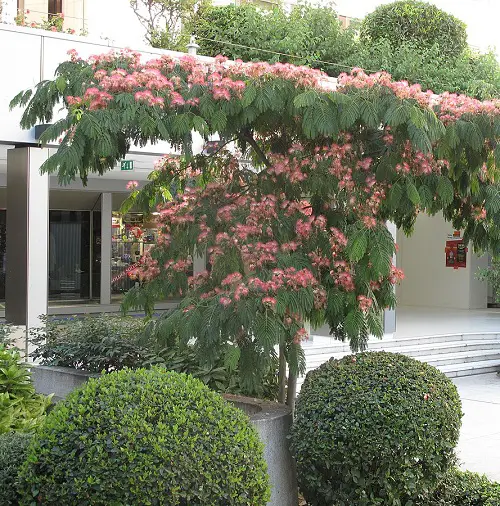
Botanical Name: Albizia julibrissin
USDA Zones: 6-9
Silk trees offer pink flowers that bloom in June and July. They have an exotic look and a pleasant fragrance.
19. Purple Leaf Sandcherry
Botanical Name: Prunus x cistena
USDA Zones: 2-8
The purple leaf sandcherry is a tall shrub known for its purple leaves. It produces fragrant white flowers in mid-spring, followed by attractive fruits that birds enjoy.
20. Crape Myrtle

Botanical Name: Lagerstroemia spp.
USDA Zones: 7-9
Crape myrtles, specifically the Lagerstroemia genus, bring vibrant colors to the landscape during late summer and early fall.
Check Best Smelling Fragrant Indoor Plants here
21. Cherry Plums
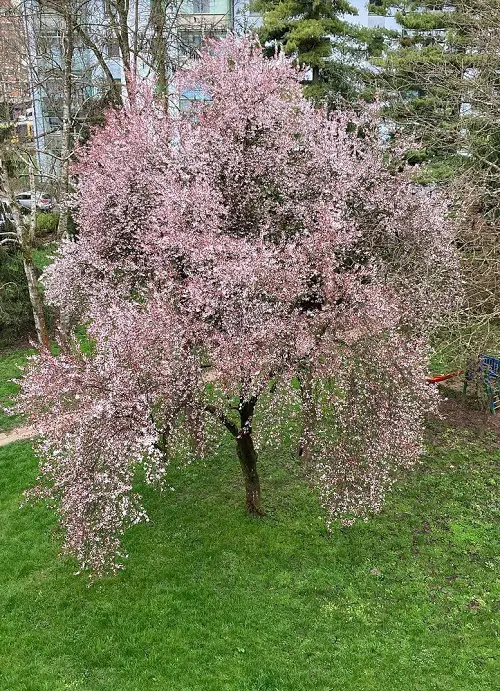
Botanical Name: Prunus cerasifera
USDA Zones: 5-8
The cherry plum is a tall shrub that can grow up to 15-20 feet in height. It’s flowers smell really nice and come out in spring.



